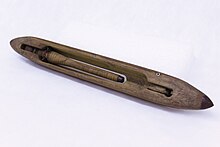Flying shuttle



The flying shuttle is a type of weaving shuttle. It was a pivotal advancement in the mechanisation of weaving during the initial stages of the Industrial Revolution, and facilitated the weaving of considerably broader fabrics, enabling the production of wider textiles. Moreover, its mechanical implementation paved the way for the introduction of automatic machine looms.
The brainchild of John Kay, the flying shuttle received a patent in the year 1733. Its implementation brought about an acceleration of the previously manual weaving process and resulted in a significant reduction in the required labour force. Formerly, a broad-cloth loom necessitated the presence of a weaver on each side, but with the advent of the flying shuttle, a solitary operator could handle the task proficiently. Prior to this breakthrough, the textile industry relied upon the coordination of four spinners to support a single weaver.
The widespread adoption of the flying shuttle by the 1750s dramatically exacerbated this labour imbalance, marking a notable shift in textile production dynamics.[1]
History
The history of this device is difficult to accurately ascertain due to poor recordings. Nonetheless, there are two general schools of thought around this; first those that believe that it appears to have been invented in the region of
Operation

In a typical frame loom, as used previous to the invention of the flying shuttle, the operator sat with the newly woven cloth before them, using treadles or some other mechanism to raise and lower the
The flying shuttle employs a board, called the "race," which runs, side to side, along the front of the beater, forming a track on which the shuttle runs. The lower threads of the shed rest on the track and the shuttle slides over them. At each end of the race, there is a box which catches the shuttle at the end of its journey, and which contains a mechanism for propelling the shuttle on its return trip.[clarification needed] The shuttle itself has some subtle differences from the older form. The ends of the shuttle are bullet-shaped and metal-capped, and the shuttle generally has rollers to reduce friction. The weft thread is made to exit from the end rather than the side, and the thread is stored on a pirn (a long, conical, one-ended, non-turning bobbin) to allow it to feed more easily. Finally, the flying shuttle is generally somewhat heavier, so as to have sufficient momentum to carry it all the way through the shed.
-
Handloom with a flying shuttle. The shuttle runs in a shuttle race attached to the front of the (bottom-mounted) beater bar.
-
Narrow tanmono loom with an obvious shuttle race on a top-mounted beater bar. Late 1800s Japan.
-
This 1893 Yorkshire-made handloom has a flying shuttle; it is not just controlled but powered by the pedals.
-
The fully-automated shuttle moves almost too fast to see.
-
An early fully-automated loom. The arms at the sides can be seen swinging to bash the flying shuttle back and forth.
Social effects
The increase in production due to the flying shuttle exceeded the capacity of the spinning industry of the day and prompted the development of powered spinning machines. Beginning with the
The flying shuttle produced a new source of injuries to the weaving process; if deflected from its path, it could be shot clear of the machine, potentially striking and injuring workers. Turn-of-the-century
Obsolescence
The flying shuttle dominated commercial weaving through the middle of the twentieth century. However, by that time, other systems had begun to replace it. The heavy shuttle was noisy and energy-inefficient (since the energy used to throw it was largely lost in the catching); also, its inertia limited the speed of the loom. Projectile and rapier looms eliminated the need to take the bobbin/pirn of thread through the shed; later, air- and water-jet looms reduced the weight of moving parts further. Flying shuttle looms are still used for some purposes, and old models remain in use.
References
- ^ "History of technology". www.historyworld.net. Retrieved 2 November 2017.
- ^ See Heller, Labour, 180-1, for Lyon; James K.J Thompson, Clermont-de-Ledéve 1633-1789: Fluctuations in the Prosperity of a Languedocian Cloth-Making Town (Cambridge: Cambridge University Press, 1982), 336-7, for Languedoc. ----- cite from an Essay Craft Guilds, Apprenticeship, and Technological Change by S. R. Epstein in the collection Guilds, Innovation, and the European Economy, 1400-1800, Cambridge University Press, 2008, page. 68
- ISBN 0-521-09418-6.
- ISBN 3704500925. Archived from the original(PDF) on 1 January 2018. Retrieved 6 February 2018.
- ^ "Flying Shuttle Invention in the Industrial Revolution". HISTORY CRUNCH - History Articles, Biographies, Infographics, Resources and More. Retrieved 25 February 2023.
- OCLC 4689281.
During the past year I have investigated many shuttle accidents, and on no occasion where serious injury had resulted, has the shuttle guard been placed in that position for which it was intended.
- Horrocks, A. Richard; Anand, S. C., eds. (2000). Handbook of technical textiles. Woodhead Publishing. pp. 87–88. ISBN 978-1-85573-385-5.
- "Leclerc Loom Options: Flying Shuttle Option". Camilla Valley Farm Weavers' Supply. Retrieved 9 February 2009.
- Harling, Nick. "John Kay 1704-1780: Inventor of the Flying Shuttle". Cotton Town. New Opportunities Fund. Archived from the original on 28 September 2007.
- Broudy, Eric (1993). The Book of Looms. University Press of New England. pp. 148, 151. ISBN 0-87451-649-8.
- "Flying Shuttle" (PDF). Master Weaver (60). November–December 1961.
- Hills, Richard (1990). "Textiles and Clothing". In McNeil, Ian (ed.). An Encyclopaedia of the History of Technology. Taylor & Francis. pp. 821–822. ISBN 0-203-33017-X.



